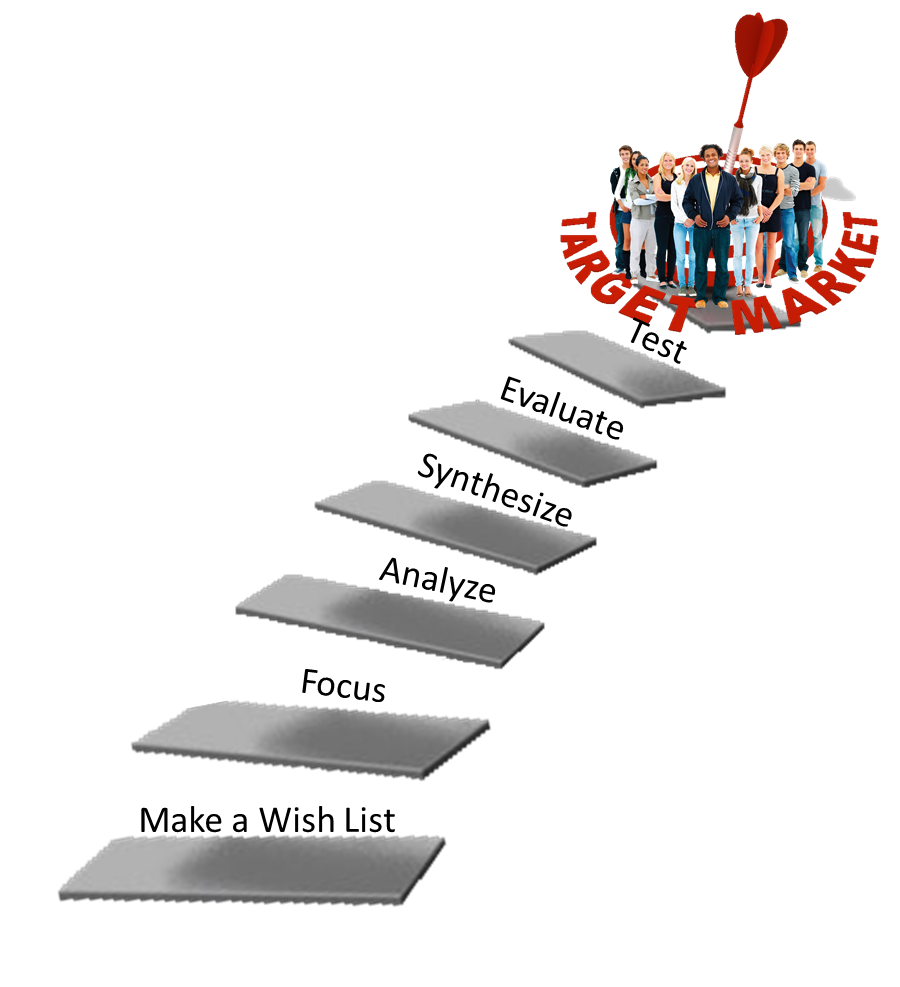“Knowing your target customer is the single most important job of any marketer,” writes Jim Joseph (@JimJosephExp), President of Americas and Chief Integrated Marketing Officer at Cohn & Wolfe, “and it’s a job that never ends.”[1] For any company to market successfully, it must know its target market and then understand the consumers who populate that niche. Joseph believes that you should begin your planning with four lists, one that includes universal truths, one that notes what is new and different, one that contains appropriate things that are trending, and a final list containing your expectations. Concerning universal truths, Joseph writes:
“Start by listing out the factors you’ve always known to be true about your customer — things you can anticipate that will likely never change so you have to continually bake it into your plan. Remembering the core features of your customer gives you a good base for continuing the elements of your marketing plan that are likely to continue to work.”
If you are in the building industry, an example of a universal truth would be: People have to get from one room to another inside a building. That might sound obvious and trivial, but you want to identify truths that don’t limit your thinking. For example, stating that people need to be able to get from one room to another doesn’t limit your thinking to traditional doors. There is a difference between asking, “How can I create a better door?” and “What’s the best way to get from one room to another?” The first question limits your thinking to doors while the second one opens up other possibilities. By identifying universal truths that don’t limit your thinking you also don’t limit your potential target market. Concerning the list of “what’s new and different,” Joseph writes:
“Add to your base knowledge with what you’ve learned this past year that might be new and different about your customer. This should include things that will likely change your plan for next year because you’ve learned something new about what your customer is looking to gain from your brand.”
You want to be particularly aware of any new developments that could completely collapse your market (i.e., so-called disruptive innovations) that could change your customers buying habits. Slide rule and adding machine manufacturers were not prepared for the advent of the electronic calculator. On the other hand, electronics firms are keenly aware of technologies like cassette tapes, compact disks, MP3 digitalization, and so forth that can appeal to consumers and change the industry. If you are not aware of what is new and different in your industry, you will never adapt in time when a tectonic shift takes place in the business landscape. Because this is so important, Joseph’s last two lists also play a role in ensuring you are not blindsided. Concerning the list about things that are trending, Joseph writes:
“It’s important to also highlight what you see brewing with your customers. Recognize issues that you see have started to take shape, but perhaps have not become universal quite yet. You’ll want to keep an eye on these issues so that you can course correct your plan throughout the year as appropriate.”
Joseph then recommends conducting some “what if” exercises that help you expand your thinking about expectations. He explains:
“Lastly, identify what issues you think might happen this year, and therefore you want to be tracking in anticipation of the following year. Maybe you’re getting a glimmer of some activity, but you’re not sure if it’ll take shape. These are issues that you want to keep an eye on for the future.”
Armed with that background you are in a much better position to identify you target market and the consumers within that market. Chuck Cohn (@chuckcohn), Founder and CEO of Varsity Tutors, and the editorial staff at Entrepreneur, independently developed steps they believe businesses can take to help them identify their target market. Cohn identifies two major steps (each containing several smaller steps).[2] The Entrepreneur staff identifies seven steps they believe businesses need to take.[3] Since there is some overlap between the two lists, I’ll use the Entrepreneur list as the basis for discussion. The first step the staff identifies is making a wish list.
“With whom do you want to do business? Be as specific as you can. Identify the geographic range and the types of businesses or customers you want your business to target. If you don’t know whom you want to do business with, you can’t make contact. … These days, the trend is toward smaller niches. Targeting teenagers isn’t specific enough; targeting male, African American teenagers with family incomes of $40,000 and up is. Aiming at companies that sell software is too broad; aiming at Northern California-based companies that provide internet software sales and training and have sales of $15 million or more is a better goal.”
Lynda Falkenstein (@DoctorNiche) told the Entrepreneur staff, “Many people talk about ‘finding’ a niche as if it were something under a rock or at the end of the rainbow, ready-made. That’s nonsense. … You must recognize that you can’t do business with everybody.” As the staff puts it, “Good niches don’t just fall into your lap; they must be carefully crafted.” The second step identified by the Entrepreneur staff is having focus. This is also Cohn’s first big step. The staff writes:
“Clarify what you want to sell, remembering that a) you can’t be all things to all people and b) smaller is bigger. Your niche isn’t the same as the field in which you work. For example, a retail clothing business is not a niche but a field. A more specific niche may be ‘maternity clothes for executive women.'”
Cohn adds, “One of the most effective things you can do to market your product smartly and efficiently is narrow your gaze — in other words, prioritize. Which efforts should you prioritize?” He offers three tips to help you sharpen your focus. First, “determine what needs your product fulfills.” As Harvard Business School marketing professor Theodore Levitt put it, “People don’t want to buy a quarter-inch drill. They want a quarter-inch hole!” Second, “use a funnel approach.” By that, Cohn means that you need to be more granular in your approach to identifying the right customers for your products or services. Finally, “emphasize primary value propositions.” In other words, you want to highlight aspects of your products and services that match the interests and desires of the people you want to buy them. Cohn’s steps to sharpen your focus are in line with the next step recommended by the Entrepreneur staff, which is describing your ideal customer’s worldview. They explain:
“A successful business uses what Falkenstein calls the Platinum Rule: ‘Do unto others as they would do unto themselves.’ When you look at the world from your prospective customers’ perspective, you can identify their needs or wants. The best way to do this is to talk to prospective customers and identify their main concerns.”
Once you have a fairly good notion of what your target market is and who your ideal customer could be, the Entrepreneur staff believes it is time to synthesize what you have learned. They elaborate:
“At this stage, your niche should begin to take shape as your ideas and the client’s needs and wants coalesce to create something new. A good niche has five qualities:
- It takes you where you want to go — in other words, it conforms to your long-term vision.
- Somebody else wants it — namely, customers.
- It’s carefully planned.
- It’s one-of-a-kind, the ‘only game in town.’
- It evolves, allowing you to develop different profit centers and still retain the core business, thus ensuring long-term success.”
Clearly, not all businesses are looking to be niche businesses (i.e., the only game in town). Bigger companies have to compete with other companies that share similar aspirations. That’s why they are always looking for a competitive edge. Targeted marketing may be the edge for which they are looking. At this point, Cohn recommends that you infuse your conclusions with objective data. Analyzing the data is in line with the Entrepreneur staff’s next recommendation which is to evaluate your position. If things don’t align the way you expected them to, the staff recommends you scrap the direction you were heading and move on to the next idea. Once you’ve selected a target market and the right consumers, the staff recommends that you conduct a test market campaign to see if you are right. They caution, “The test shouldn’t cost you a lot of money.” Finally, the staff recommends that you “go for it!” They note, “Fear not: If you did your homework, entering the market will be a calculated risk, not just a gamble.” Cohn concludes, “Your end goal is to make it easy for your target demographic groups to see connections between their needs and your product. The analysis of multiple streams of data, as well as a continual effort to identify your target customers, can help you achieve this end and maximize your ROI.”
Footnotes
[1] Jim Joseph, “The Most Important Piece of a Marketing Plan Is Your Targeted Customer,” Entrepreneur, 4 February 2015.
[2] Chuck Cohn, “Steps To Identify Your Target Market,” Forbes, 6 February 2015.
[3] Staff, “7 Steps to Defining Your Niche Market,” Entrepreneur, 30 December 2014.





